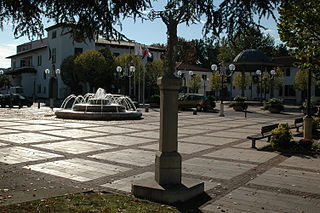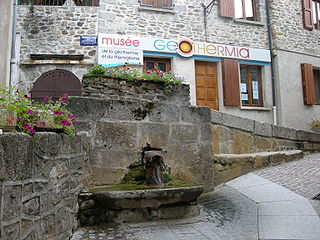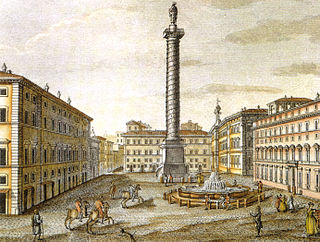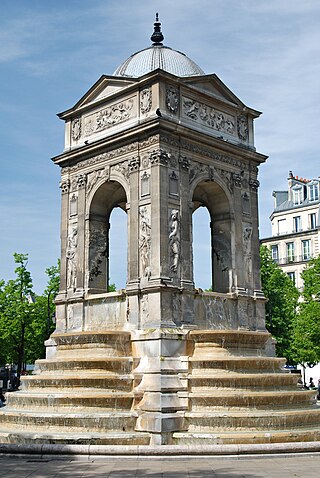
Bayonne is a city in Southwestern France near the Spanish border. It is a commune and one of two subprefectures in the Pyrénées-Atlantiques department, in the Nouvelle-Aquitaine region.

Gascony was a province of the southwestern Kingdom of France that succeeded the Duchy of Gascony (602–1453). From the 17th century until the French Revolution (1789–1799), it was part of the combined Province of Guyenne and Gascony. The region is vaguely defined, and the distinction between Guyenne and Gascony is unclear; by some they are seen to overlap, while others consider Gascony a part of Guyenne. Most definitions put Gascony east and south of Bordeaux.

The Castalian Spring, in the ravine between the Phaedriades at Delphi, is where all visitors to Delphi — the contestants in the Pythian Games, and especially pilgrims who came to consult the Delphic Oracle — stopped to wash themselves and quench their thirst; it is also here that the Pythia and the priests cleansed themselves before the oracle-giving process. Finally Roman poets regarded it as a source of poetic inspiration. According to some mythological versions it was here that Apollo killed the monster, Python, who was guarding the spring, and that is why it was considered to be sacred.

The Place de la Concorde is a public square in Paris, France. Measuring 7.6 ha in area, it is the largest square in the French capital. It is located in the city's eighth arrondissement, at the eastern end of the Champs-Élysées.

A fountain, from the Latin "fons", meaning source or spring, is a decorative reservoir used for discharging water. It is also a structure that jets water into the air for a decorative or dramatic effect.

Tarbes is a commune in the Hautes-Pyrénées department in the Occitanie region of southwestern France. It is the capital of Bigorre and of the Hautes-Pyrénées. It has been a commune since 1790. It was known as Turba or Tarba in Roman times. Tarbes is part of the historical region of Gascony.

Dax is a commune in Nouvelle-Aquitaine, southwestern France, sub-prefecture of the Landes department.

Bagnères-de-Bigorre is a commune and subprefecture of the Hautes-Pyrénées Department in the Occitanie region of southwestern France.

Anglet is a commune in the Pyrénées-Atlantiques department in the Nouvelle-Aquitaine region of southwestern France.

Chaudes-Aigues is a commune in the Cantal department in south-central France. It is a spa town, famous for its hot spring waters.

The fountain in the Piazza Colonna is a fountain in Rome, Italy, designed by the architect Giacomo Della Porta and constructed by the Fiesole sculptor Rocco Rossi between 1575 and 1577.

Fontaine-de-Vaucluse is a commune in the southeastern French department of Vaucluse. Its name comes from the spring of the same name; the name Vaucluse itself comes from the Latin phrase vallis clausa or "closed valley".
Acionna was a Gallo-Roman water goddess, attested in the Orléanais region.

The Fontaine des Innocents is a monumental public fountain located on the place Joachim-du-Bellay in the Les Halles district in the 1st arrondissement of Paris, France. Originally called the Fountain of the Nymphs, it was constructed between 1547 and 1550 by architect Pierre Lescot and sculptor Jean Goujon in the new style of the French Renaissance. It is the oldest monumental fountain in Paris.

The Medici Fountain is a monumental fountain in the Jardin du Luxembourg in the 6th arrondissement in Paris. Built in about 1630, it was commissioned by Marie de' Medici, the widow of King Henry IV of France and regent of King Louis XIII of France. It was moved to its present location and extensively rebuilt in 1864-1866.

The Fountains in Paris originally provided drinking water for city residents, and now are decorative features in the city's squares and parks. Paris has more than two hundred fountains, the oldest dating back to the 16th century. It also has more than one hundred Wallace drinking fountains. Most of the fountains are the property of the municipality.

The Fontana delle Tartarughe is a fountain of the late Italian Renaissance, located in Piazza Mattei, in the Sant'Angelo district of Rome, Italy. It was built between 1580 and 1588 by the architect Giacomo della Porta and the sculptor Taddeo Landini. The bronze turtles around the upper basin, usually attributed either to Gian Lorenzo Bernini or Andrea Sacchi, were added in either 1658 or 1659 when the fountain was restored.
The Fountains of St. Peter's Square are two fountains in St. Peter's Square in Vatican City, created by Carlo Maderno (1612–1614) and Gian Lorenzo Bernini (1667–1677) to ornament the square in front of St. Peter's Basilica. The older fountain, by Maderno, is on the north side of the square.

La Fontaine Castle was a castle in Clausen, Luxembourg. The elaborate building was the residence of Peter Ernst I von Mansfeld-Vorderort, governor of Luxembourg, who began its construction in 1563 and continued to extend it until his death in 1604. For this reason, it is also known as the Palais Mansfeld or Mansfeld Palace. Almost nothing remains of it at present.

Fountains in France provided drinking water to the inhabitants of the ancient Roman cities of France, and to French monasteries and villages during the Middle Ages. Later, they were symbols of royal power and grandeur in the gardens of the kings of France. Today, though they no longer provide drinking water, they decorate the squares and parks of French cities and towns.























